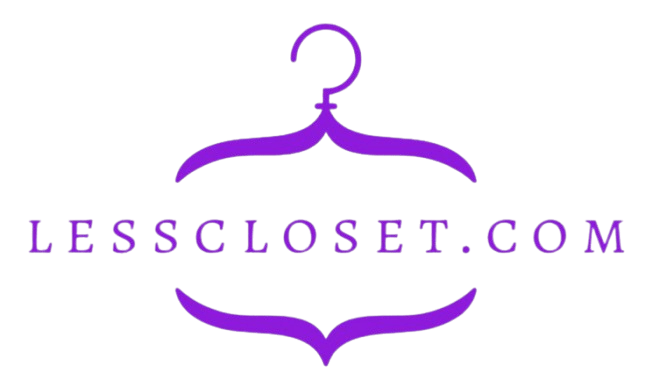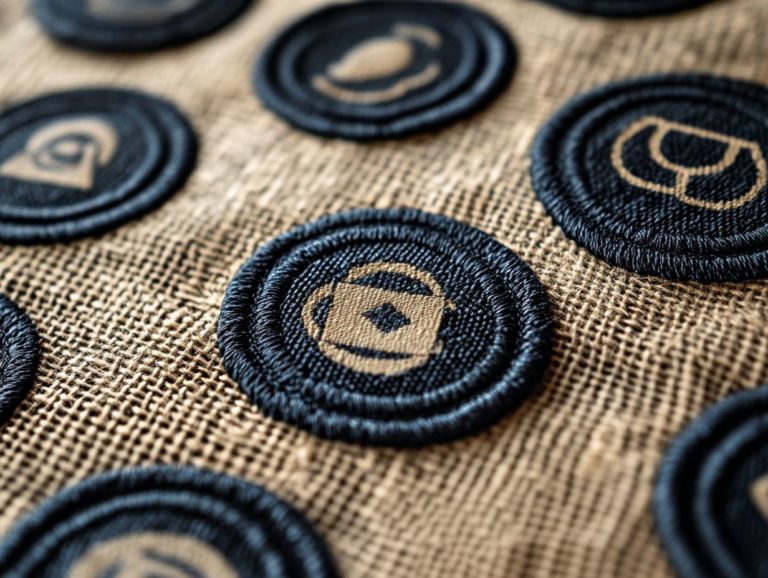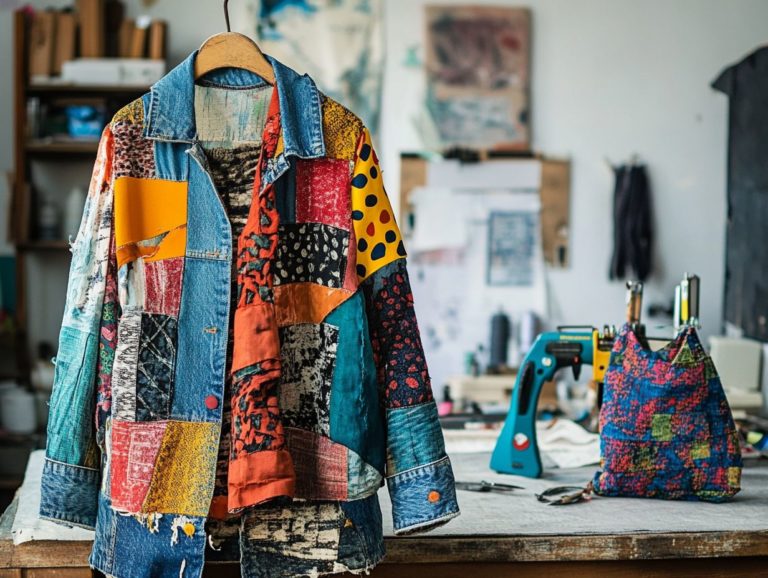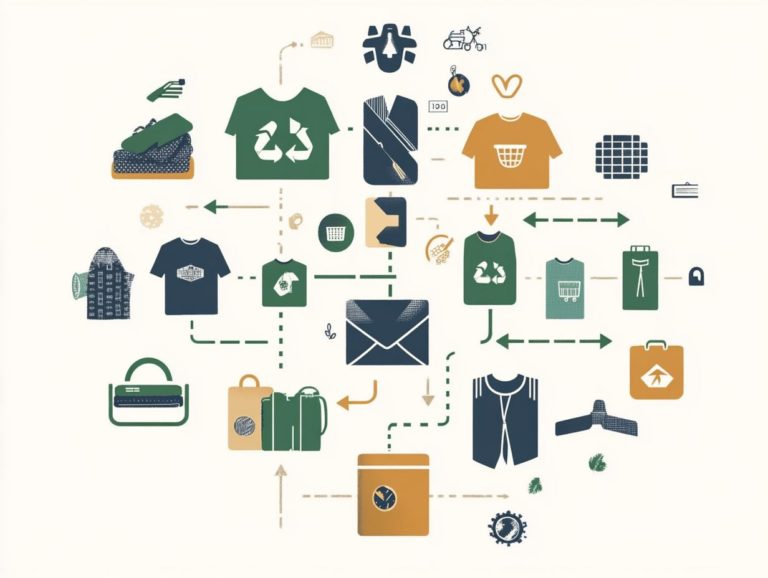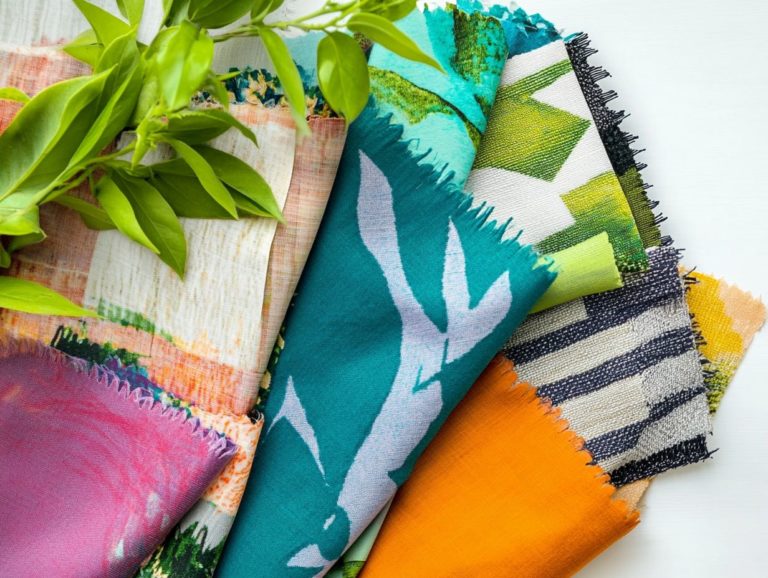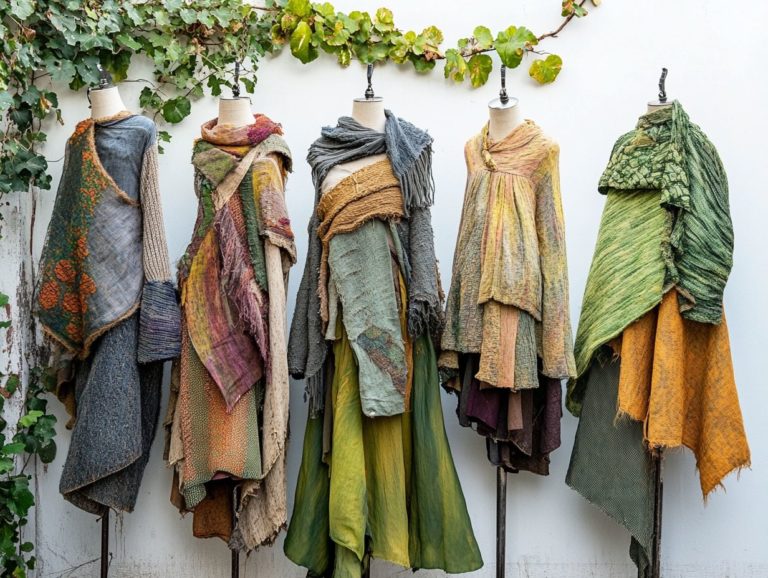How to Build a Sustainable Fashion Brand
In today s world, sustainability in fashion transcends mere trendiness. It has become an essential pursuit. As you become more aware of your environmental impact, carbon footprint, and the need for emissions reduction, brands are compelled to adapt and innovate in response to your growing consciousness.
This article delves into the significance of sustainable fashion brands and outlines a clear roadmap for building a brand that embodies eco-friendly values. From selecting sustainable materials to actively engaging your customers, you ll discover key steps to take, navigate common challenges, and explore future trends that are reshaping the industry.
Embark on this journey toward a more responsible and stylish future one where your choices make a meaningful impact.
Contents
- Key Takeaways:
- The Importance of Sustainability in Fashion
- Steps to Building a Sustainable Fashion Brand
- Challenges and Solutions for Sustainable Fashion Brands
- The Future of Sustainable Fashion
- Frequently Asked Questions
- What does it mean to build a sustainable fashion brand?
- Why is it important to build a sustainable fashion brand?
- What are some ways to build a sustainable fashion brand?
- How can I make my fashion brand more sustainable?
- What are some challenges when building a sustainable fashion brand?
- How can I educate my customers about sustainable fashion?
Key Takeaways:

The Importance of Sustainability in Fashion
Sustainability in fashion transcends fleeting trends. It serves as an important factor that influences the entire industry, shaping how you shop and what you like while addressing the urgent challenges posed by climate change and globalization.
As awareness of environmental practices grows, you increasingly demand transparency and proof that brands follow ethical practices. This shift has elevated the significance of sustainable fashion, which strives to mitigate the adverse effects of fast fashion and its impact on the environment.
It’s essential that fashion brands commit to using eco-friendly materials and responsible manufacturing processes. This ultimately contributes to a healthier planet for all.
Why Sustainable Fashion Matters
Sustainable fashion matters to you because it represents a commitment to ethical practices that safeguard the environment and promote responsible consumer behavior in the face of climate change.
By prioritizing eco-friendly materials like organic cotton, Tencel, and recycled fibers, you significantly reduce pollution and conserve precious natural resources. With the fashion industry being one of the major culprits in global waste, embracing sustainable fashion methods allows you to lessen the carbon footprint tied to clothing production.
As consumers like you increasingly gravitate toward brands that reflect your values, how to make sustainable fashion choices daily reshapes your purchasing decisions and heightens your awareness of environmental impacts. This collective shift not only drives innovation in areas like biodegradable textiles and recycling processes but also paves the way for a more sustainable future for both the industry and our planet.
Steps to Building a Sustainable Fashion Brand
Creating a sustainable fashion brand demands a comprehensive strategy. This includes thoughtful materials sourcing, ethical labor practices, and a steadfast commitment to transparency throughout every facet of production and marketing.
1. Research and Educate Yourself
Start your journey by researching sustainable fashion. Understand key principles, the marketplace, and consumer behavior trends.
By undertaking this journey, you ll cultivate a profound understanding of what sustainability truly encompasses, including the many environmental, social, and economic factors at play. This insight gives you the power to make informed decisions and guides you in selecting relevant certifications, such as Fair Trade or Global Organic Textile Standard (GOTS). This can greatly boost your brand’s credibility and attract more conscious consumers!
Conduct thorough market research to identify and connect with conscious consumers and their purchasing decisions who prioritize ethical and eco-friendly practices. For those looking to deepen their understanding of this movement, exploring how to explore sustainable fashion further can provide valuable insights. With this solid foundation, you can effectively position your brand in a competitive landscape, align your values with consumer expectations, and ultimately cultivate a loyal customer base that shares your vision.
2. Choose Sustainable Materials and Production Processes

Choosing sustainable materials like organic cotton and recycled polyester is essential for minimizing the environmental impact of production in the fashion industry.
These materials help protect ecosystems by cutting down on pesticide use and landfill waste. They also foster a more ethical approach to sourcing. For example, organic cotton supports healthier soil and boosts biodiversity. Meanwhile, recycled polyester keeps plastic out of oceans and landfills, turning waste into valuable resources.
Encourage manufacturers to adopt innovative, sustainable processes. This will pave the way for greener practices in the industry. You can advocate for water-efficient dyeing techniques and low-energy production methods, which collectively contribute to a smaller carbon footprint.
By prioritizing sustainable materials and ethical practices, the fashion industry can lead the charge toward a greener future, ensuring that your choices as a consumer resonate with environmental stewardship.
3. Create a Strong Brand Identity
A robust brand identity is crucial for your sustainable fashion brand. It conveys transparency regarding environmental practices and fosters trust among consumers who prioritize ethical consumption.
By integrating storytelling into your brand s narrative, you can illuminate the journey of each product from the sourcing of materials to the skilled artisans who bring them to life. This narrative creates a deeper emotional connection with your audience, making them feel invested in your mission.
Collaborating with ethical partners who share your values not only boosts your credibility but also encourages mutual growth within the community. By maintaining transparency through clear labeling and open dialogue you empower consumers to make informed choices, reinforcing your commitment to sustainability and enhancing your brand s overall appeal.
4. Partner with Ethical Suppliers and Manufacturers
Partnering with ethical suppliers and manufacturers is essential as you build a sustainable fashion brand. This ensures that labor practices align with ethical standards and genuinely contribute to the well-being of workers.
By prioritizing alliances with organizations that emphasize fair wages, safe working conditions, and proper certifications, you not only enhance your credibility but also foster trust with increasingly conscious consumers. This commitment to social responsibility resonates strongly in today s market, where transparency and sustainability are paramount.
As you advocate for ethical labor practices, you can help drive positive shifts within the industry, inspiring other businesses to follow your lead. Cultivating such partnerships will create a more loyal customer base, enhancing brand loyalty and ultimately driving long-term profitability.
5. Implement Sustainable Packaging and Shipping Practices
Implementing biodegradable packaging and sustainable shipping practices is essential to reducing emissions and minimizing environmental impact in the fashion industry. Act now to embrace sustainable packaging!
A genuine commitment to sustainability can take many forms. Utilize biodegradable materials, opt for recycled cardboard, and adopt minimalistic sustainable design practices that eliminate excess waste. Understanding the importance of sustainable fashion advocacy helps reinforce these efforts. Brands that adopt innovative packaging enhance their image. They also help protect our planet.
Integrating energy-efficient transportation methods think electric delivery vehicles and optimized shipping routes further enhances these efforts by significantly reducing carbon dioxide emissions. By prioritizing these practices, you can foster a more responsible approach to retail, harmonizing profit motives with the well-being of both the environment and society as a whole.
6. Educate and Engage Your Customers
Educating and engaging customers is crucial for sustainable fashion brands. It nurtures a community of informed consumers passionate about ethical and eco-friendly practices.
Incorporate strategies like interactive workshops, informative online content, and eco-friendly product tracing to inspire loyalty and foster a deeper understanding of your mission. Sharing captivating stories about the materials you use and the artisans behind your creations emphasizes the significance of conscious consumption and forges an emotional connection with your audience. Additionally, consider providing insights on how to transition to a sustainable wardrobe to further engage and educate them.
Leverage social media platforms for campaigns that promote sharing sustainable practices to amplify your message. This encourages broader participation and raises awareness. These initiatives can instill a sense of responsibility and pride among your consumers, guiding them toward more sustainable choices.
Challenges and Solutions for Sustainable Fashion Brands

Sustainable fashion brands encounter a myriad of challenges, ranging from fierce competition with fast fashion to the relentless pressures of the market and the intricate dynamics of globalization.
However, by embracing innovative solutions, they can carve out a path to success and truly thrive in this ever-evolving landscape.
Overcoming Obstacles and Finding Solutions
Overcoming obstacles in the sustainable fashion industry demands a commitment to innovative solutions and collaborative partnerships among brands, suppliers, and consumers.
Embracing new technologies and sharing best practices streamlines supply chains while ensuring that ethical production methods remain a priority. When you collaborate with a diverse array of entities from textile manufacturers to eco-conscious retailers, you contribute to the development of new, sustainable materials that significantly minimize environmental impact. Additionally, looking at sustainable fashion icons can inspire you to adopt more eco-friendly practices in your own wardrobe.
Engaging consumers in the sustainability dialogue raises awareness and gives them the power to make informed choices that support responsible brands. This collective approach not only tackles existing challenges but also paves the way for a more resilient and accountable industry.
The Future of Sustainable Fashion
The future of sustainable fashion holds immense promise, fueled by emerging trends and innovations that tackle pressing challenges such as climate change and evolving consumer behaviors.
Trends and Innovations in Sustainable Fashion
Trends and innovations in sustainable fashion are continuously evolving, with an increasing emphasis on eco-friendly materials and initiatives that prioritize sustainability and engage consumers.
Recent developments highlight a significant shift towards a system where clothes are recycled and reused, where recycling and upcycling the process of creatively reusing materials to make new products garments take center stage in the mission to reduce waste. Brands are diving into biodegradable fabrics and natural dyes, which not only minimize environmental impact but also resonate with consumers who are keen on making conscientious choices. To learn more about the movement, check out this guide on how to educate others about sustainable fashion.
Innovative technologies such as 3D knitting and digital printing are transforming the production process, allowing for minimal waste and customized fits that cater to individual preferences. Collaborative efforts among designers, consumers, and sustainability advocates are paving the way for transparent supply chains, giving you the power to make informed choices that support ethical production. To stay ahead, explore the future of sustainable fashion and the trends to follow.
These trends are driving the industry toward a more responsible and sustainable future.
This video explores the latest in sustainable fashion and the impact of innovative practices.
Frequently Asked Questions
What does it mean to build a sustainable fashion brand?

Building a sustainable fashion brand means creating a business model that focuses on minimizing harm to the environment, promoting ethical production, and supporting social responsibility. It involves making conscious decisions that consider the impact on people and the planet, while still delivering high-quality and stylish products.
Why is it important to build a sustainable fashion brand?
Building a sustainable fashion brand is crucial because the fashion industry is one of the largest contributors to environmental and social issues. By incorporating sustainable practices, brands can reduce their negative impact and contribute to creating a healthier and more equitable world for future generations.
What are some ways to build a sustainable fashion brand?
There are many ways to build a sustainable fashion brand, including using eco-friendly materials, implementing ethical production processes, reducing waste, and promoting transparency. Brands can also partner with organizations or initiatives that align with their values and contribute to positive change.
How can I make my fashion brand more sustainable?
You can make your fashion brand more sustainable by starting small and gradually implementing changes. This can include using sustainable materials, practicing responsible sourcing, and promoting circular fashion by designing products that can be reused or recycled. Educating yourself and your team on sustainable practices is also vital.
What are some challenges when building a sustainable fashion brand?
Finding and sourcing sustainable materials can be tricky but is essential for success! Maintaining affordable prices and competing with fast fashion brands are also significant challenges. Additionally, educating consumers on the importance of sustainable fashion and changing their shopping habits can be difficult.
How can I educate my customers about sustainable fashion?
You can educate your customers about sustainable fashion by providing information on your brand’s website or social media platforms, hosting events or workshops, and including sustainability messaging in your product packaging. Collaborating with influencers or partnering with sustainable organizations can also help spread awareness about your brand’s values.
Join the movement toward sustainable fashion today!
